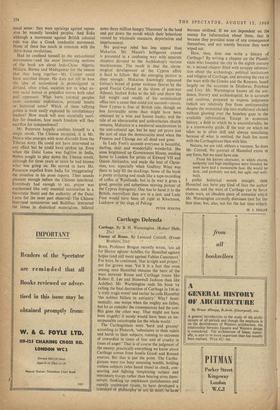Carthago Delenda
Carthage. By B. H. Warmington. (Robert Hale, Enemy of Rome. By Leonard Cottrell. (Evans
Brothers, 21s:) • ••• • Boys, Professor Brogan recently Wrote, 'are all for Hector against Achilles, 'for Hannibal againq Scipio (and still more against Fabius Cunctator).' For boys, he continued, 'that is right and proper.' not for grown men. Yet it is a fact that even among men Hannibal remains the hero of the wars between Rome and Carthage (more like Robert E. Lee and Stonewall Jackson than like Achilles). Mr. Warmington ends his book by calling the final destruction of Carthage in 146 BC 'a truly tragic event' and earlier he calls Hannibal 'the noblest failure in antiquity.' Why? Senti- mentally, one weeps when the mighty are fallen, but let us consider the consequences had the con- flict gone the other way. That might not have been tragedy; it surely would have been an un- surpassable catastrophe for the whole world.
The Carthaginians were 'hard and gloomy' according to Plutarch, 'submissive to their rulers and harsh to their subjects, running to extremes of cowardice in times of fear and of cruelty :n times of anger.' That is of course the judgment of the enemy; practically everything we know about Carthage comes from hostile Greek and Roman sources. But that is just the point. The Cartha- ginians were too busy amassing wealth, holding restless subjects (who hated them) in check, con- quering and fighting (employing subject and mercenary troops rather than bearing arms them- selves), thinking up unpleasant punishments and equally unpleasant rituals, to have developed a literature or ilhilosophy of art, in shbil, lo•have'
become civilised. If we are dependent on the enemy for information about them, that is because they provided none of any consequence themselves, and not merely because they were wiped out.
How, then, does one write a history of Carthage? By writing a chapter on the Phoeni- cians who founded the city in the eighth century BC, a second chapter filled with scrappy informa- tion about the archaeology, political institutions and religion of Carthage, and devoting the rest to the wars with the Greeks and the Romans, based largely on the accounts in Diodorus, Polybius and Livy. Mr. Warmington knoWs all the evi- dence, literary and archaeological, he is accurate and cautious, prepared to express judgments (which are relatively free from sentimentality despite the occasional slip into traditional clichds) without glossing over the hopeless gaps in the available information. Except in economic history, a field in which he is uncomfortable, he is a trustworthy guide. If the tour on which he takes us is often dull and always tantalising because of what is omitted, the fault lies more with the Carthaginians than with him.
Nature, we are told, abhors a vacuum. So does Mr. Cottrell. No portrait of Hannibal exists !n any form, but we must have one.
From his known character, in which charm, authority and high intelligence were blended, he must have had a memorable face. He would be dark, and probably not tall, but agile and well- built.
I prefer historical novels straight; then Hannibal can have any kind of face the author chooses, and the wars of Carthage can be fierce trade wars, an obsolete piece of nonsense which Mr. Warmington correctly dismisses (not for the first time, but, alas, not for the last time either).


































 Previous page
Previous page